Essay on the Causes of Global Warming: Human Influence and Impact
VerifiedAdded on 2022/08/29
|7
|2203
|19
Essay
AI Summary
This essay provides a comprehensive analysis of the undeniable link between human activities and global warming. It details how human actions, such as the burning of fossil fuels, industrialization, deforestation, and agricultural practices, are the primary drivers of increasing greenhouse gas emissions, leading to a rise in global temperatures. The essay emphasizes the role of carbon dioxide, methane, and nitrous oxide in trapping heat and altering the Earth's climate. It explores the impacts of these changes, including extreme weather events, and the potential consequences for both flora and fauna. Furthermore, the essay discusses the contributions of various sectors, including energy production, cement manufacturing, transportation, and agriculture, to the escalating levels of pollution. It concludes by acknowledging the role of natural phenomena while highlighting the overwhelming impact of human activities, calling for global cooperation and significant measures to mitigate the effects of climate change.
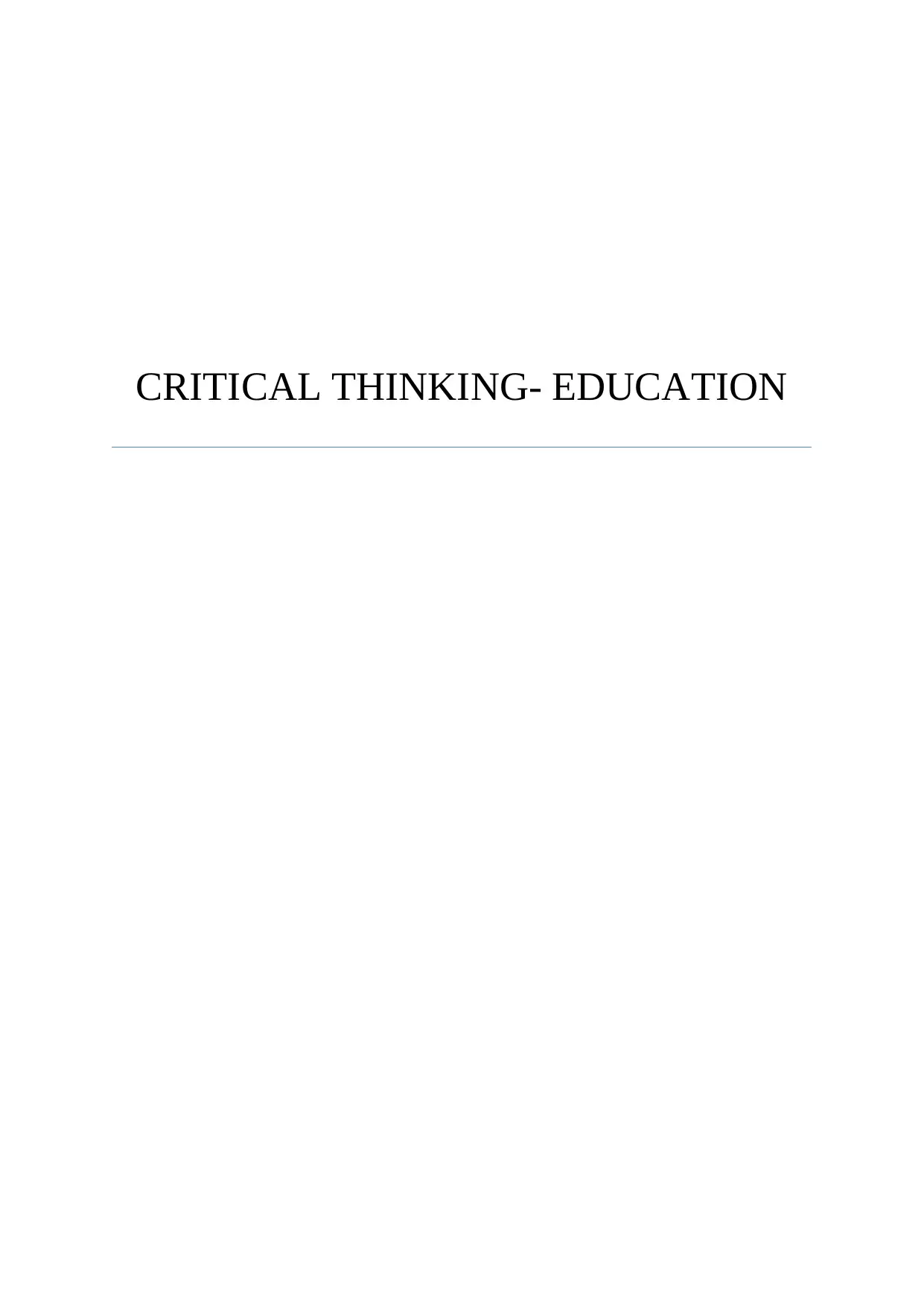
CRITICAL THINKING- EDUCATION
Paraphrase This Document
Need a fresh take? Get an instant paraphrase of this document with our AI Paraphraser
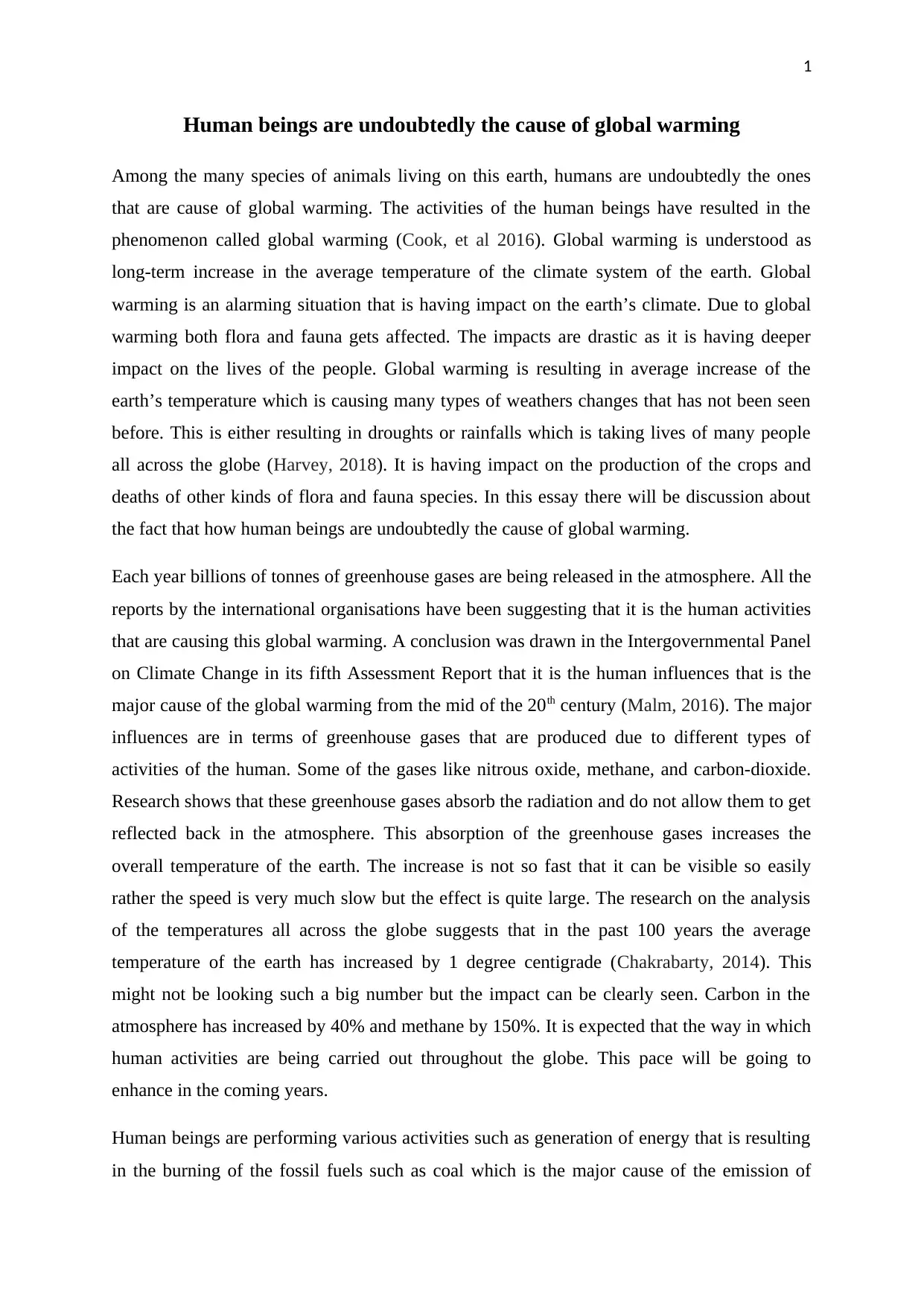
1
Human beings are undoubtedly the cause of global warming
Among the many species of animals living on this earth, humans are undoubtedly the ones
that are cause of global warming. The activities of the human beings have resulted in the
phenomenon called global warming (Cook, et al 2016). Global warming is understood as
long-term increase in the average temperature of the climate system of the earth. Global
warming is an alarming situation that is having impact on the earth’s climate. Due to global
warming both flora and fauna gets affected. The impacts are drastic as it is having deeper
impact on the lives of the people. Global warming is resulting in average increase of the
earth’s temperature which is causing many types of weathers changes that has not been seen
before. This is either resulting in droughts or rainfalls which is taking lives of many people
all across the globe (Harvey, 2018). It is having impact on the production of the crops and
deaths of other kinds of flora and fauna species. In this essay there will be discussion about
the fact that how human beings are undoubtedly the cause of global warming.
Each year billions of tonnes of greenhouse gases are being released in the atmosphere. All the
reports by the international organisations have been suggesting that it is the human activities
that are causing this global warming. A conclusion was drawn in the Intergovernmental Panel
on Climate Change in its fifth Assessment Report that it is the human influences that is the
major cause of the global warming from the mid of the 20th century (Malm, 2016). The major
influences are in terms of greenhouse gases that are produced due to different types of
activities of the human. Some of the gases like nitrous oxide, methane, and carbon-dioxide.
Research shows that these greenhouse gases absorb the radiation and do not allow them to get
reflected back in the atmosphere. This absorption of the greenhouse gases increases the
overall temperature of the earth. The increase is not so fast that it can be visible so easily
rather the speed is very much slow but the effect is quite large. The research on the analysis
of the temperatures all across the globe suggests that in the past 100 years the average
temperature of the earth has increased by 1 degree centigrade (Chakrabarty, 2014). This
might not be looking such a big number but the impact can be clearly seen. Carbon in the
atmosphere has increased by 40% and methane by 150%. It is expected that the way in which
human activities are being carried out throughout the globe. This pace will be going to
enhance in the coming years.
Human beings are performing various activities such as generation of energy that is resulting
in the burning of the fossil fuels such as coal which is the major cause of the emission of
Human beings are undoubtedly the cause of global warming
Among the many species of animals living on this earth, humans are undoubtedly the ones
that are cause of global warming. The activities of the human beings have resulted in the
phenomenon called global warming (Cook, et al 2016). Global warming is understood as
long-term increase in the average temperature of the climate system of the earth. Global
warming is an alarming situation that is having impact on the earth’s climate. Due to global
warming both flora and fauna gets affected. The impacts are drastic as it is having deeper
impact on the lives of the people. Global warming is resulting in average increase of the
earth’s temperature which is causing many types of weathers changes that has not been seen
before. This is either resulting in droughts or rainfalls which is taking lives of many people
all across the globe (Harvey, 2018). It is having impact on the production of the crops and
deaths of other kinds of flora and fauna species. In this essay there will be discussion about
the fact that how human beings are undoubtedly the cause of global warming.
Each year billions of tonnes of greenhouse gases are being released in the atmosphere. All the
reports by the international organisations have been suggesting that it is the human activities
that are causing this global warming. A conclusion was drawn in the Intergovernmental Panel
on Climate Change in its fifth Assessment Report that it is the human influences that is the
major cause of the global warming from the mid of the 20th century (Malm, 2016). The major
influences are in terms of greenhouse gases that are produced due to different types of
activities of the human. Some of the gases like nitrous oxide, methane, and carbon-dioxide.
Research shows that these greenhouse gases absorb the radiation and do not allow them to get
reflected back in the atmosphere. This absorption of the greenhouse gases increases the
overall temperature of the earth. The increase is not so fast that it can be visible so easily
rather the speed is very much slow but the effect is quite large. The research on the analysis
of the temperatures all across the globe suggests that in the past 100 years the average
temperature of the earth has increased by 1 degree centigrade (Chakrabarty, 2014). This
might not be looking such a big number but the impact can be clearly seen. Carbon in the
atmosphere has increased by 40% and methane by 150%. It is expected that the way in which
human activities are being carried out throughout the globe. This pace will be going to
enhance in the coming years.
Human beings are performing various activities such as generation of energy that is resulting
in the burning of the fossil fuels such as coal which is the major cause of the emission of
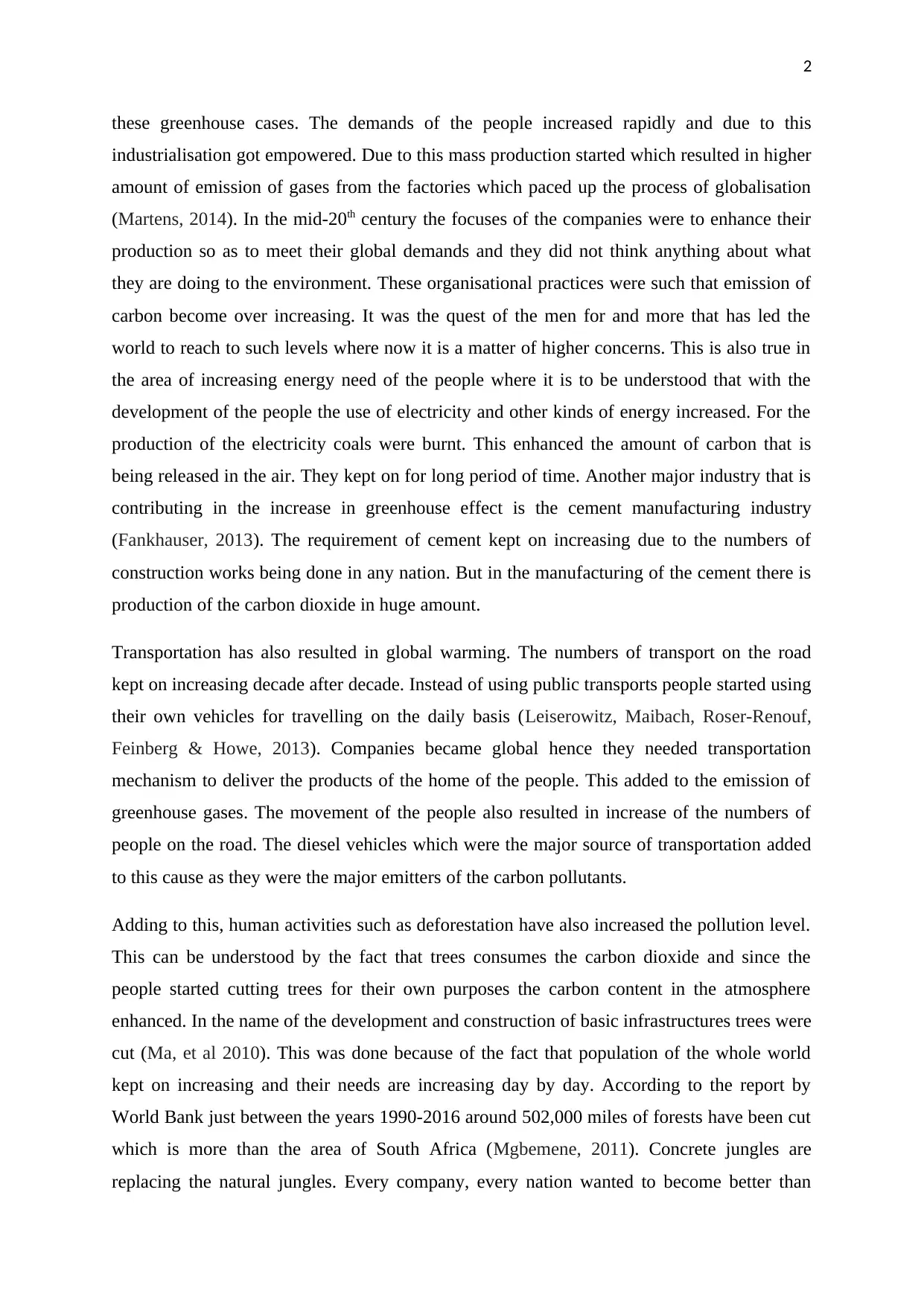
2
these greenhouse cases. The demands of the people increased rapidly and due to this
industrialisation got empowered. Due to this mass production started which resulted in higher
amount of emission of gases from the factories which paced up the process of globalisation
(Martens, 2014). In the mid-20th century the focuses of the companies were to enhance their
production so as to meet their global demands and they did not think anything about what
they are doing to the environment. These organisational practices were such that emission of
carbon become over increasing. It was the quest of the men for and more that has led the
world to reach to such levels where now it is a matter of higher concerns. This is also true in
the area of increasing energy need of the people where it is to be understood that with the
development of the people the use of electricity and other kinds of energy increased. For the
production of the electricity coals were burnt. This enhanced the amount of carbon that is
being released in the air. They kept on for long period of time. Another major industry that is
contributing in the increase in greenhouse effect is the cement manufacturing industry
(Fankhauser, 2013). The requirement of cement kept on increasing due to the numbers of
construction works being done in any nation. But in the manufacturing of the cement there is
production of the carbon dioxide in huge amount.
Transportation has also resulted in global warming. The numbers of transport on the road
kept on increasing decade after decade. Instead of using public transports people started using
their own vehicles for travelling on the daily basis (Leiserowitz, Maibach, Roser-Renouf,
Feinberg & Howe, 2013). Companies became global hence they needed transportation
mechanism to deliver the products of the home of the people. This added to the emission of
greenhouse gases. The movement of the people also resulted in increase of the numbers of
people on the road. The diesel vehicles which were the major source of transportation added
to this cause as they were the major emitters of the carbon pollutants.
Adding to this, human activities such as deforestation have also increased the pollution level.
This can be understood by the fact that trees consumes the carbon dioxide and since the
people started cutting trees for their own purposes the carbon content in the atmosphere
enhanced. In the name of the development and construction of basic infrastructures trees were
cut (Ma, et al 2010). This was done because of the fact that population of the whole world
kept on increasing and their needs are increasing day by day. According to the report by
World Bank just between the years 1990-2016 around 502,000 miles of forests have been cut
which is more than the area of South Africa (Mgbemene, 2011). Concrete jungles are
replacing the natural jungles. Every company, every nation wanted to become better than
these greenhouse cases. The demands of the people increased rapidly and due to this
industrialisation got empowered. Due to this mass production started which resulted in higher
amount of emission of gases from the factories which paced up the process of globalisation
(Martens, 2014). In the mid-20th century the focuses of the companies were to enhance their
production so as to meet their global demands and they did not think anything about what
they are doing to the environment. These organisational practices were such that emission of
carbon become over increasing. It was the quest of the men for and more that has led the
world to reach to such levels where now it is a matter of higher concerns. This is also true in
the area of increasing energy need of the people where it is to be understood that with the
development of the people the use of electricity and other kinds of energy increased. For the
production of the electricity coals were burnt. This enhanced the amount of carbon that is
being released in the air. They kept on for long period of time. Another major industry that is
contributing in the increase in greenhouse effect is the cement manufacturing industry
(Fankhauser, 2013). The requirement of cement kept on increasing due to the numbers of
construction works being done in any nation. But in the manufacturing of the cement there is
production of the carbon dioxide in huge amount.
Transportation has also resulted in global warming. The numbers of transport on the road
kept on increasing decade after decade. Instead of using public transports people started using
their own vehicles for travelling on the daily basis (Leiserowitz, Maibach, Roser-Renouf,
Feinberg & Howe, 2013). Companies became global hence they needed transportation
mechanism to deliver the products of the home of the people. This added to the emission of
greenhouse gases. The movement of the people also resulted in increase of the numbers of
people on the road. The diesel vehicles which were the major source of transportation added
to this cause as they were the major emitters of the carbon pollutants.
Adding to this, human activities such as deforestation have also increased the pollution level.
This can be understood by the fact that trees consumes the carbon dioxide and since the
people started cutting trees for their own purposes the carbon content in the atmosphere
enhanced. In the name of the development and construction of basic infrastructures trees were
cut (Ma, et al 2010). This was done because of the fact that population of the whole world
kept on increasing and their needs are increasing day by day. According to the report by
World Bank just between the years 1990-2016 around 502,000 miles of forests have been cut
which is more than the area of South Africa (Mgbemene, 2011). Concrete jungles are
replacing the natural jungles. Every company, every nation wanted to become better than
⊘ This is a preview!⊘
Do you want full access?
Subscribe today to unlock all pages.

Trusted by 1+ million students worldwide
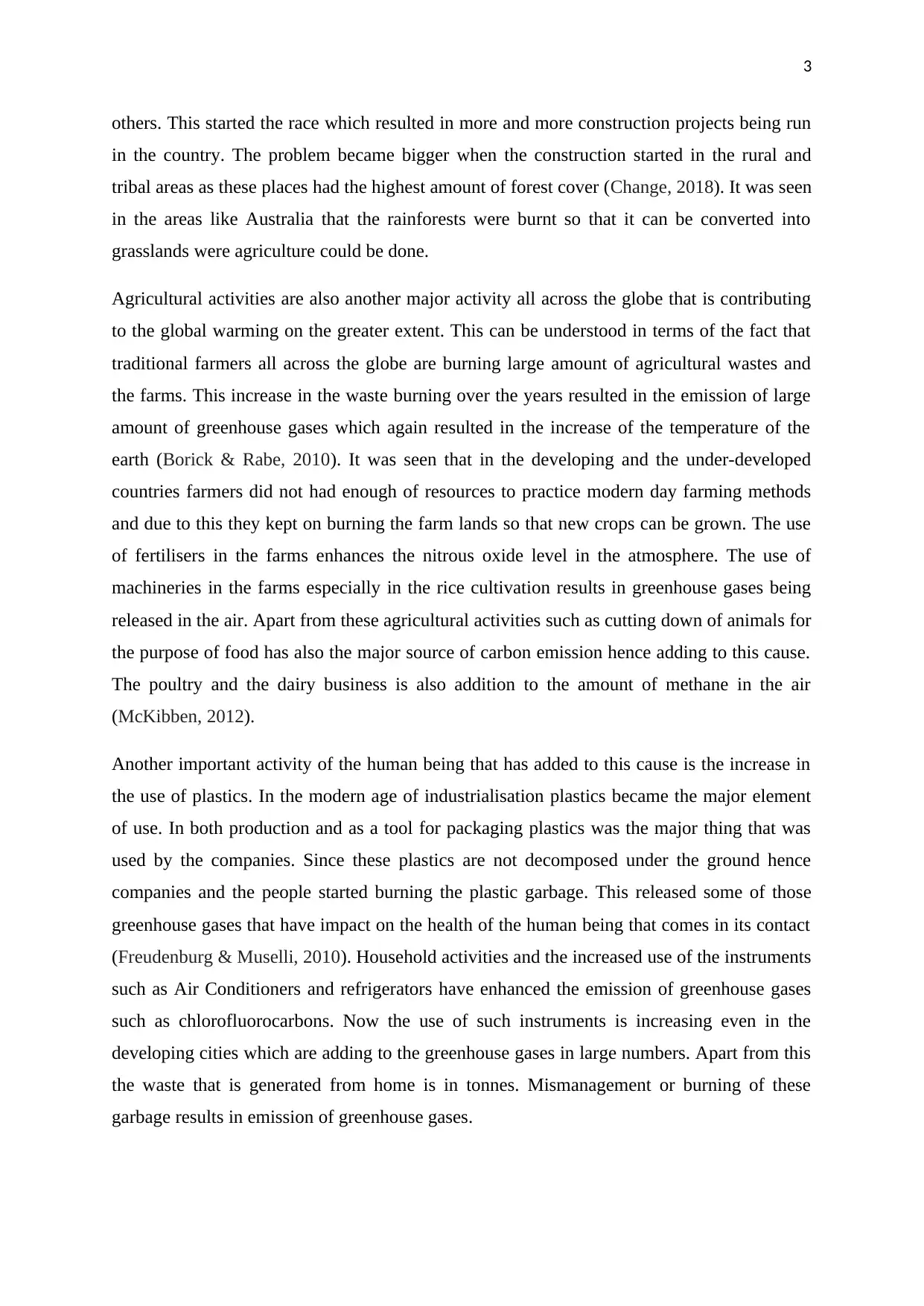
3
others. This started the race which resulted in more and more construction projects being run
in the country. The problem became bigger when the construction started in the rural and
tribal areas as these places had the highest amount of forest cover (Change, 2018). It was seen
in the areas like Australia that the rainforests were burnt so that it can be converted into
grasslands were agriculture could be done.
Agricultural activities are also another major activity all across the globe that is contributing
to the global warming on the greater extent. This can be understood in terms of the fact that
traditional farmers all across the globe are burning large amount of agricultural wastes and
the farms. This increase in the waste burning over the years resulted in the emission of large
amount of greenhouse gases which again resulted in the increase of the temperature of the
earth (Borick & Rabe, 2010). It was seen that in the developing and the under-developed
countries farmers did not had enough of resources to practice modern day farming methods
and due to this they kept on burning the farm lands so that new crops can be grown. The use
of fertilisers in the farms enhances the nitrous oxide level in the atmosphere. The use of
machineries in the farms especially in the rice cultivation results in greenhouse gases being
released in the air. Apart from these agricultural activities such as cutting down of animals for
the purpose of food has also the major source of carbon emission hence adding to this cause.
The poultry and the dairy business is also addition to the amount of methane in the air
(McKibben, 2012).
Another important activity of the human being that has added to this cause is the increase in
the use of plastics. In the modern age of industrialisation plastics became the major element
of use. In both production and as a tool for packaging plastics was the major thing that was
used by the companies. Since these plastics are not decomposed under the ground hence
companies and the people started burning the plastic garbage. This released some of those
greenhouse gases that have impact on the health of the human being that comes in its contact
(Freudenburg & Muselli, 2010). Household activities and the increased use of the instruments
such as Air Conditioners and refrigerators have enhanced the emission of greenhouse gases
such as chlorofluorocarbons. Now the use of such instruments is increasing even in the
developing cities which are adding to the greenhouse gases in large numbers. Apart from this
the waste that is generated from home is in tonnes. Mismanagement or burning of these
garbage results in emission of greenhouse gases.
others. This started the race which resulted in more and more construction projects being run
in the country. The problem became bigger when the construction started in the rural and
tribal areas as these places had the highest amount of forest cover (Change, 2018). It was seen
in the areas like Australia that the rainforests were burnt so that it can be converted into
grasslands were agriculture could be done.
Agricultural activities are also another major activity all across the globe that is contributing
to the global warming on the greater extent. This can be understood in terms of the fact that
traditional farmers all across the globe are burning large amount of agricultural wastes and
the farms. This increase in the waste burning over the years resulted in the emission of large
amount of greenhouse gases which again resulted in the increase of the temperature of the
earth (Borick & Rabe, 2010). It was seen that in the developing and the under-developed
countries farmers did not had enough of resources to practice modern day farming methods
and due to this they kept on burning the farm lands so that new crops can be grown. The use
of fertilisers in the farms enhances the nitrous oxide level in the atmosphere. The use of
machineries in the farms especially in the rice cultivation results in greenhouse gases being
released in the air. Apart from these agricultural activities such as cutting down of animals for
the purpose of food has also the major source of carbon emission hence adding to this cause.
The poultry and the dairy business is also addition to the amount of methane in the air
(McKibben, 2012).
Another important activity of the human being that has added to this cause is the increase in
the use of plastics. In the modern age of industrialisation plastics became the major element
of use. In both production and as a tool for packaging plastics was the major thing that was
used by the companies. Since these plastics are not decomposed under the ground hence
companies and the people started burning the plastic garbage. This released some of those
greenhouse gases that have impact on the health of the human being that comes in its contact
(Freudenburg & Muselli, 2010). Household activities and the increased use of the instruments
such as Air Conditioners and refrigerators have enhanced the emission of greenhouse gases
such as chlorofluorocarbons. Now the use of such instruments is increasing even in the
developing cities which are adding to the greenhouse gases in large numbers. Apart from this
the waste that is generated from home is in tonnes. Mismanagement or burning of these
garbage results in emission of greenhouse gases.
Paraphrase This Document
Need a fresh take? Get an instant paraphrase of this document with our AI Paraphraser
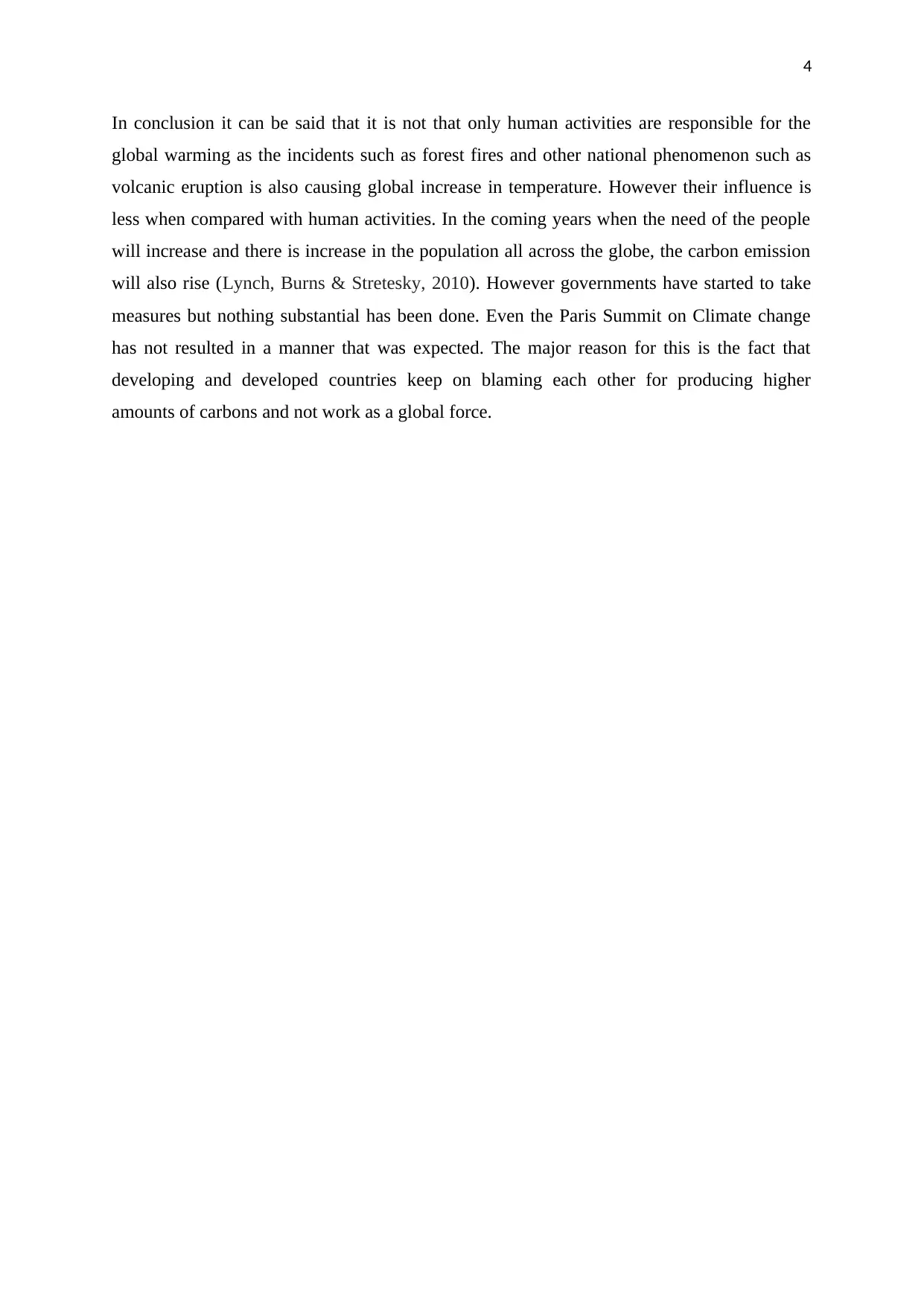
4
In conclusion it can be said that it is not that only human activities are responsible for the
global warming as the incidents such as forest fires and other national phenomenon such as
volcanic eruption is also causing global increase in temperature. However their influence is
less when compared with human activities. In the coming years when the need of the people
will increase and there is increase in the population all across the globe, the carbon emission
will also rise (Lynch, Burns & Stretesky, 2010). However governments have started to take
measures but nothing substantial has been done. Even the Paris Summit on Climate change
has not resulted in a manner that was expected. The major reason for this is the fact that
developing and developed countries keep on blaming each other for producing higher
amounts of carbons and not work as a global force.
In conclusion it can be said that it is not that only human activities are responsible for the
global warming as the incidents such as forest fires and other national phenomenon such as
volcanic eruption is also causing global increase in temperature. However their influence is
less when compared with human activities. In the coming years when the need of the people
will increase and there is increase in the population all across the globe, the carbon emission
will also rise (Lynch, Burns & Stretesky, 2010). However governments have started to take
measures but nothing substantial has been done. Even the Paris Summit on Climate change
has not resulted in a manner that was expected. The major reason for this is the fact that
developing and developed countries keep on blaming each other for producing higher
amounts of carbons and not work as a global force.
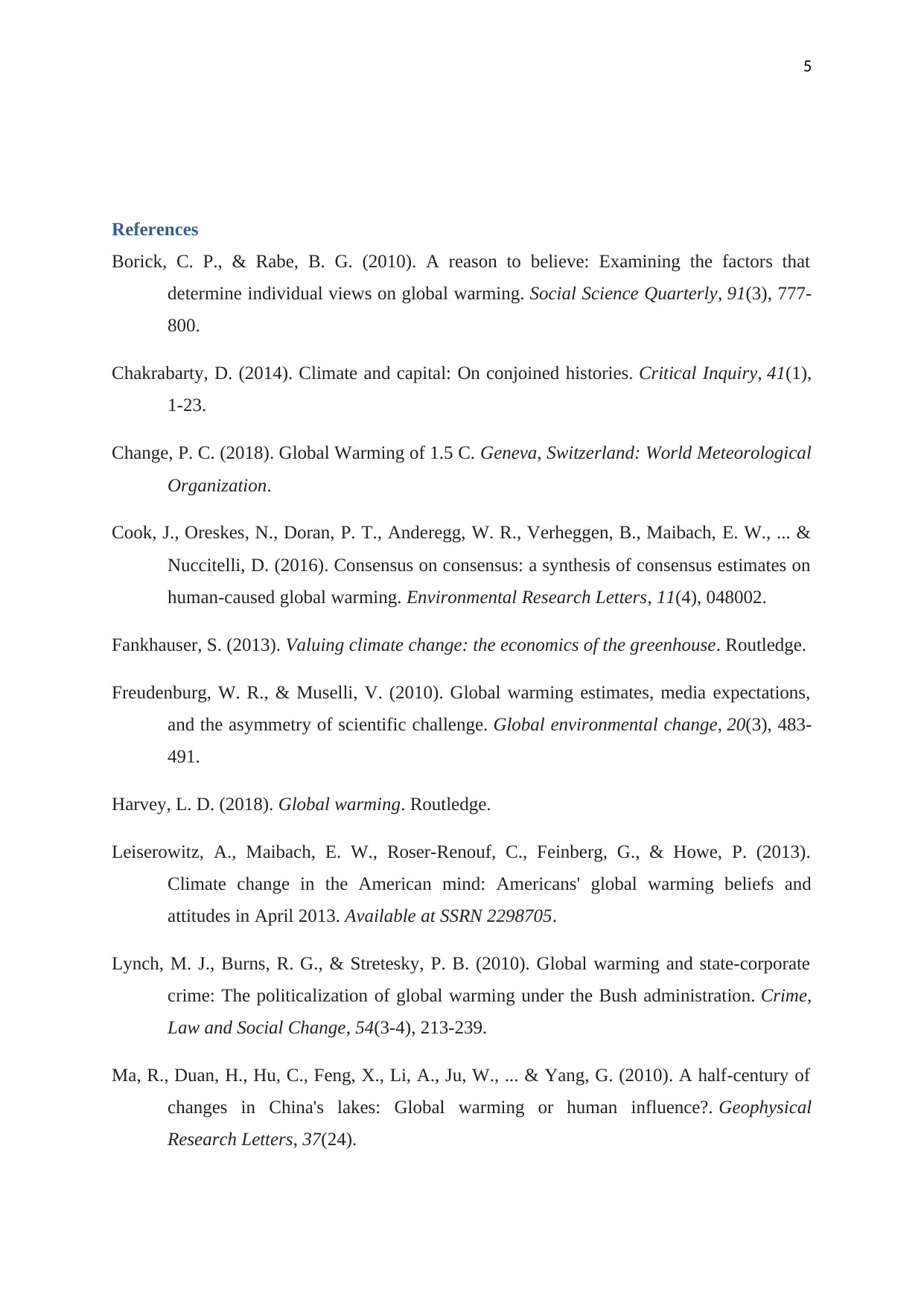
5
References
Borick, C. P., & Rabe, B. G. (2010). A reason to believe: Examining the factors that
determine individual views on global warming. Social Science Quarterly, 91(3), 777-
800.
Chakrabarty, D. (2014). Climate and capital: On conjoined histories. Critical Inquiry, 41(1),
1-23.
Change, P. C. (2018). Global Warming of 1.5 C. Geneva, Switzerland: World Meteorological
Organization.
Cook, J., Oreskes, N., Doran, P. T., Anderegg, W. R., Verheggen, B., Maibach, E. W., ... &
Nuccitelli, D. (2016). Consensus on consensus: a synthesis of consensus estimates on
human-caused global warming. Environmental Research Letters, 11(4), 048002.
Fankhauser, S. (2013). Valuing climate change: the economics of the greenhouse. Routledge.
Freudenburg, W. R., & Muselli, V. (2010). Global warming estimates, media expectations,
and the asymmetry of scientific challenge. Global environmental change, 20(3), 483-
491.
Harvey, L. D. (2018). Global warming. Routledge.
Leiserowitz, A., Maibach, E. W., Roser-Renouf, C., Feinberg, G., & Howe, P. (2013).
Climate change in the American mind: Americans' global warming beliefs and
attitudes in April 2013. Available at SSRN 2298705.
Lynch, M. J., Burns, R. G., & Stretesky, P. B. (2010). Global warming and state-corporate
crime: The politicalization of global warming under the Bush administration. Crime,
Law and Social Change, 54(3-4), 213-239.
Ma, R., Duan, H., Hu, C., Feng, X., Li, A., Ju, W., ... & Yang, G. (2010). A half‐century of
changes in China's lakes: Global warming or human influence?. Geophysical
Research Letters, 37(24).
References
Borick, C. P., & Rabe, B. G. (2010). A reason to believe: Examining the factors that
determine individual views on global warming. Social Science Quarterly, 91(3), 777-
800.
Chakrabarty, D. (2014). Climate and capital: On conjoined histories. Critical Inquiry, 41(1),
1-23.
Change, P. C. (2018). Global Warming of 1.5 C. Geneva, Switzerland: World Meteorological
Organization.
Cook, J., Oreskes, N., Doran, P. T., Anderegg, W. R., Verheggen, B., Maibach, E. W., ... &
Nuccitelli, D. (2016). Consensus on consensus: a synthesis of consensus estimates on
human-caused global warming. Environmental Research Letters, 11(4), 048002.
Fankhauser, S. (2013). Valuing climate change: the economics of the greenhouse. Routledge.
Freudenburg, W. R., & Muselli, V. (2010). Global warming estimates, media expectations,
and the asymmetry of scientific challenge. Global environmental change, 20(3), 483-
491.
Harvey, L. D. (2018). Global warming. Routledge.
Leiserowitz, A., Maibach, E. W., Roser-Renouf, C., Feinberg, G., & Howe, P. (2013).
Climate change in the American mind: Americans' global warming beliefs and
attitudes in April 2013. Available at SSRN 2298705.
Lynch, M. J., Burns, R. G., & Stretesky, P. B. (2010). Global warming and state-corporate
crime: The politicalization of global warming under the Bush administration. Crime,
Law and Social Change, 54(3-4), 213-239.
Ma, R., Duan, H., Hu, C., Feng, X., Li, A., Ju, W., ... & Yang, G. (2010). A half‐century of
changes in China's lakes: Global warming or human influence?. Geophysical
Research Letters, 37(24).
⊘ This is a preview!⊘
Do you want full access?
Subscribe today to unlock all pages.

Trusted by 1+ million students worldwide
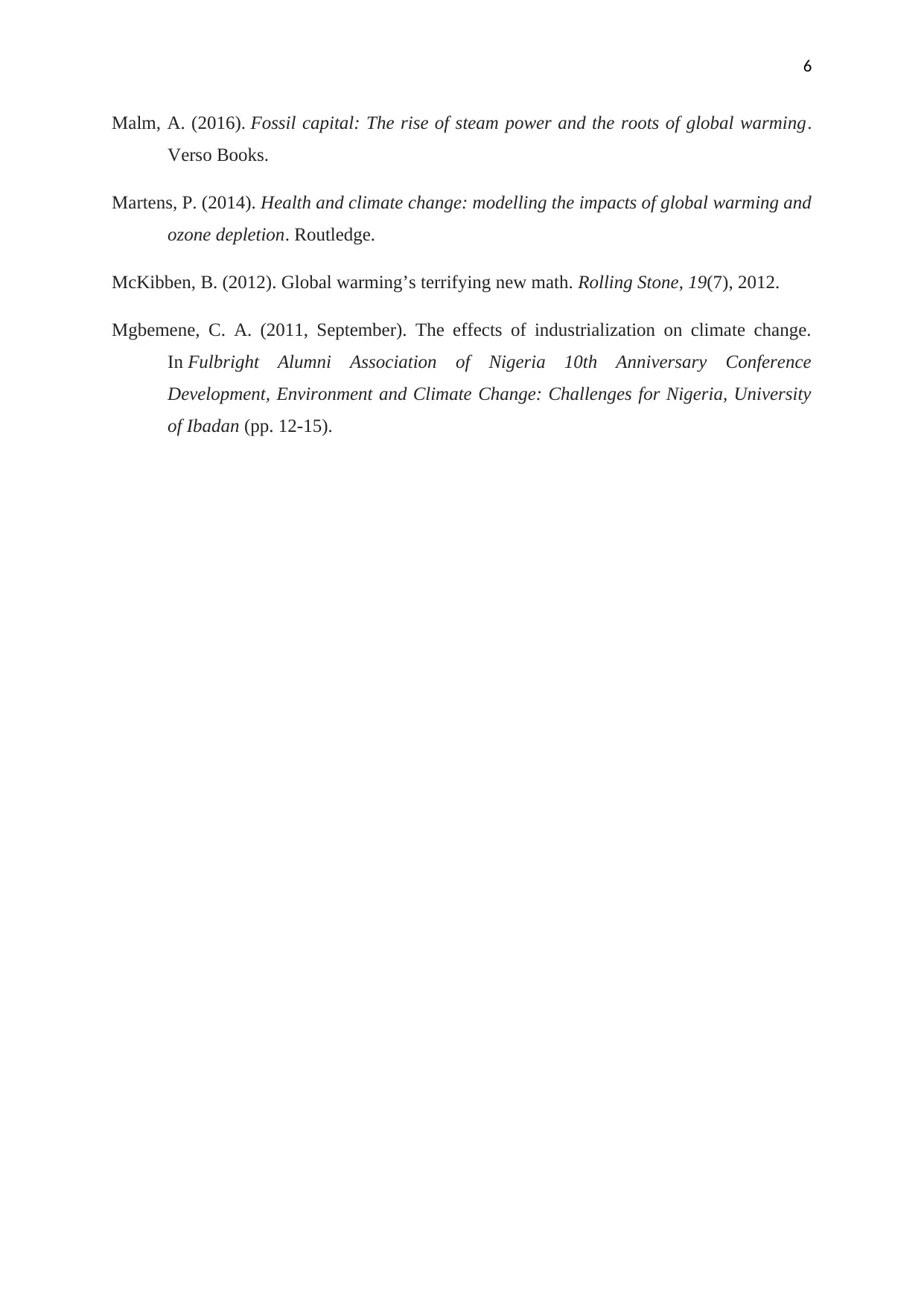
6
Malm, A. (2016). Fossil capital: The rise of steam power and the roots of global warming.
Verso Books.
Martens, P. (2014). Health and climate change: modelling the impacts of global warming and
ozone depletion. Routledge.
McKibben, B. (2012). Global warming’s terrifying new math. Rolling Stone, 19(7), 2012.
Mgbemene, C. A. (2011, September). The effects of industrialization on climate change.
In Fulbright Alumni Association of Nigeria 10th Anniversary Conference
Development, Environment and Climate Change: Challenges for Nigeria, University
of Ibadan (pp. 12-15).
Malm, A. (2016). Fossil capital: The rise of steam power and the roots of global warming.
Verso Books.
Martens, P. (2014). Health and climate change: modelling the impacts of global warming and
ozone depletion. Routledge.
McKibben, B. (2012). Global warming’s terrifying new math. Rolling Stone, 19(7), 2012.
Mgbemene, C. A. (2011, September). The effects of industrialization on climate change.
In Fulbright Alumni Association of Nigeria 10th Anniversary Conference
Development, Environment and Climate Change: Challenges for Nigeria, University
of Ibadan (pp. 12-15).
1 out of 7
Related Documents
Your All-in-One AI-Powered Toolkit for Academic Success.
+13062052269
info@desklib.com
Available 24*7 on WhatsApp / Email
![[object Object]](/_next/static/media/star-bottom.7253800d.svg)
Unlock your academic potential
Copyright © 2020–2025 A2Z Services. All Rights Reserved. Developed and managed by ZUCOL.





